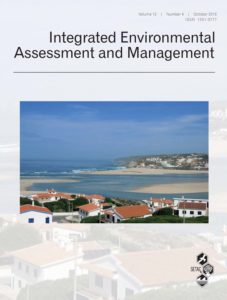2016
Posthuma, L. (National Institute for Public Health & the Environment (RIVM)); Dyer, S. (The Procter & Gamble Company); de Zwart, D. (DdZ Ecotox); Kapo, K.E. (Waterborne Environmental, Inc); Holmes, C.M. (Waterborne Environmental, Inc); Burton Jr., G.A. (University of Michigan)
Eco-epidemiology of Aquatic Ecosystems: Separating Chemicals from Multiple Stressors Journal Article
In: Science of The Total Environment, vol. 573, pp. 1303-1319, 2016.
Abstract | Links | Tags: 2016, Peer-Reviewed Publication
@article{2016EcoEpi,
title = {Eco-epidemiology of Aquatic Ecosystems: Separating Chemicals from Multiple Stressors},
author = {Posthuma, L. (National Institute for Public Health & the Environment (RIVM)) and Dyer, S. (The Procter & Gamble Company) and de Zwart, D. (DdZ Ecotox) and Kapo, K.E. (Waterborne Environmental, Inc) and Holmes, C.M. (Waterborne Environmental, Inc) and Burton Jr., G.A. (University of Michigan)},
url = {https://www.sciencedirect.com/science/article/abs/pii/S0048969716314322?via%3Dihub, Online publication
https://ars.els-cdn.com/content/image/1-s2.0-S0048969716314322-fx1_lrg.jpg, Graphical abstract},
doi = {https://doi.org/10.1016/j.scitotenv.2016.06.242},
year = {2016},
date = {2016-06-29},
urldate = {2016-06-29},
journal = {Science of The Total Environment},
volume = {573},
pages = {1303-1319},
abstract = {A non-toxic environment and a good ecological status are policy goals guiding research and management of chemicals and surface water systems in Europe and elsewhere. Research and policies on chemicals and water are however still disparate and unable to evaluate the relative ecological impacts of chemical mixtures and other stressors. This paper defines and explores the use of eco-epidemiological analysis of surveillance monitoring data sets via a proxy to quantify mixture impacts on ecosystems. Case studies show examples of different, progressive steps that are possible.
Case study data were obtained for various regions in Europe and the United States. Data types relate to potential stressors at various scales, concerning landscape, land-use, in-stream physico-chemical and pollutant data, and data on fish and invertebrates. The proxy-values for mixture impacts were quantified as predicted (multi-substance) Potentially Affected Fractions of species (msPAF), using Species Sensitivity Distribution (SSD) models in conjunction with bioavailability and mixture models.
The case studies summarize the monitoring data sets and the subsequent diagnostic bioassessments. Variation in mixture toxic pressures amongst sites appeared to covary with abundance changes in large (50–86%) percentages of taxa for the various study regions. This shows that an increased mixture toxic pressure (msPAF) relates to increased ecological impacts. Subsequent multi-stressor evaluations resulted in statistically significant, site-specific diagnosis of the magnitudes of ecological impacts and the relative contributions of different stress factors to those impacts. This included both mixtures and individual chemicals. These results allow for ranking stressors, sites and impacted species groups. That is relevant information for water management.
The case studies are discussed in relation to policy and management strategies that support reaching a non-toxic environment and good ecological status. Reaching these goals requires not only focused sectoral policies, such as on chemical- or water management, but also an overarching and solution-focused view.},
keywords = {2016, Peer-Reviewed Publication},
pubstate = {published},
tppubtype = {article}
}
Case study data were obtained for various regions in Europe and the United States. Data types relate to potential stressors at various scales, concerning landscape, land-use, in-stream physico-chemical and pollutant data, and data on fish and invertebrates. The proxy-values for mixture impacts were quantified as predicted (multi-substance) Potentially Affected Fractions of species (msPAF), using Species Sensitivity Distribution (SSD) models in conjunction with bioavailability and mixture models.
The case studies summarize the monitoring data sets and the subsequent diagnostic bioassessments. Variation in mixture toxic pressures amongst sites appeared to covary with abundance changes in large (50–86%) percentages of taxa for the various study regions. This shows that an increased mixture toxic pressure (msPAF) relates to increased ecological impacts. Subsequent multi-stressor evaluations resulted in statistically significant, site-specific diagnosis of the magnitudes of ecological impacts and the relative contributions of different stress factors to those impacts. This included both mixtures and individual chemicals. These results allow for ranking stressors, sites and impacted species groups. That is relevant information for water management.
The case studies are discussed in relation to policy and management strategies that support reaching a non-toxic environment and good ecological status. Reaching these goals requires not only focused sectoral policies, such as on chemical- or water management, but also an overarching and solution-focused view.
Kapo, K.E. (Waterborne Environmental, Inc); DeLeo, P.C. (American Cleaning Institute); Vamshi, R. (Waterborne Environmental, Inc); Holmes, C.M. (Waterborne Environmental, Inc); Ferrer, D. (American Cleaning Institute); Dyer, S. (The Procter & Gamble Company); Wang, X. (University of Cincinnati); White-Hull, C. (The Procter & Gamble Company)
istreem®: An Approach for Broad‐Scale in‐Stream Exposure Assessment of “Down‐the‐Drain” Chemicals Journal Article
In: Integrated Environmental Assessment and Management, vol. 12, no. 4, pp. 782-792, 2016.
Abstract | Links | Tags: 2016, Peer-Reviewed Publication
@article{2016iSTREEM,
title = {istreem®: An Approach for Broad‐Scale in‐Stream Exposure Assessment of “Down‐the‐Drain” Chemicals},
author = {Kapo, K.E. (Waterborne Environmental, Inc) and DeLeo, P.C. (American Cleaning Institute) and Vamshi, R. (Waterborne Environmental, Inc) and Holmes, C.M. (Waterborne Environmental, Inc) and Ferrer, D. (American Cleaning Institute) and Dyer, S. (The Procter & Gamble Company) and Wang, X. (University of Cincinnati) and White-Hull, C. (The Procter & Gamble Company)},
url = {https://setac.onlinelibrary.wiley.com/doi/abs/10.1002/ieam.1793, View Online},
doi = {https://doi.org/10.1002/ieam.1793},
year = {2016},
date = {2016-05-07},
urldate = {2016-05-07},
journal = {Integrated Environmental Assessment and Management},
volume = {12},
number = {4},
pages = {782-792},
abstract = {The “in-stream exposure model” iSTREEM®, a Web-based model made freely available to the public by the American Cleaning Institute, provides a means to estimate concentrations of “down-the-drain” chemicals in effluent, receiving waters, and drinking water intakes across national and regional scales under mean annual and low-flow conditions. We provide an overview of the evolution and utility of the iSTREEM model as a screening-level risk assessment tool relevant for down-the-drain products. The spatial nature of the model, integrating point locations of facilities along a hydrologic network, provides a powerful framework to assess environmental exposure and risk in a spatial context. A case study compared national distributions of modeled concentrations of the fragrance 1,3,4,6,7,8-Hexahydro-4,6,6,7,8,8,-hexamethylcyclopenta-γ-2-benzopyran (HHCB) and the insect repellent N,N-Diethyl-m-toluamide (DEET) to available monitoring data at comparable flow conditions. The iSTREEM low-flow model results yielded a conservative distribution of values, whereas the mean-flow model results more closely resembled the concentration distribution of monitoring data. We demonstrate how model results can be used to construct a conservative estimation of the distribution of chemical concentrations for effluents and streams leading to the derivation of a predicted environmental concentration (PEC) using the high end of the concentration distribution (e.g., 90th percentile). Data requirements, assumptions, and applications of iSTREEM are discussed in the context of other down-the-drain modeling approaches to enhance understanding of comparative advantages and uncertainties for prospective users interested in exposure modeling for ecological risk assessment. Integr Environ Assess Manag 2016;12:782–792. © 2016 SETAC },
keywords = {2016, Peer-Reviewed Publication},
pubstate = {published},
tppubtype = {article}
}


